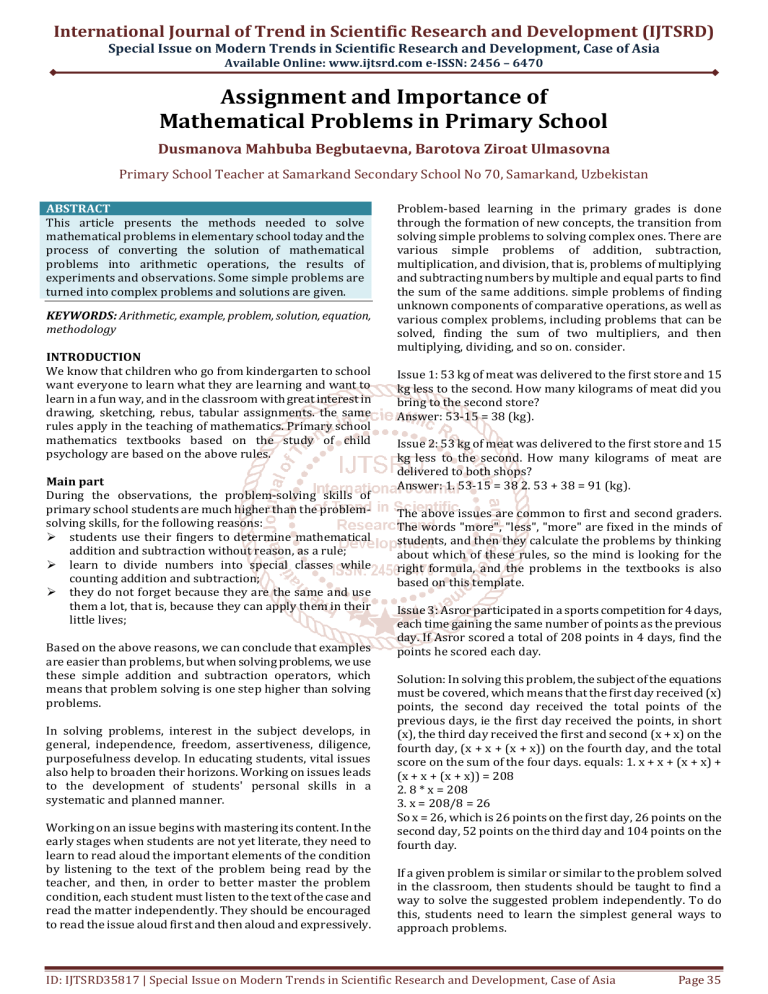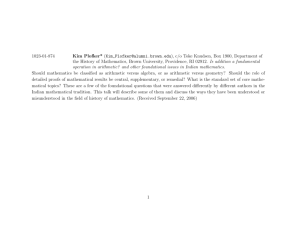
International Journal of Trend in Scientific Research and Development (IJTSRD) Special Issue on Modern Trends in Scientific Research and Development, Case of Asia Available Online: www.ijtsrd.com e-ISSN: 2456 – 6470 Assignment and Importance of Mathematical Problems in Primary School Dusmanova Mahbuba Begbutaevna, Barotova Ziroat Ulmasovna Primary School Teacher at Samarkand Secondary School No 70, Samarkand, Uzbekistan ABSTRACT This article presents the methods needed to solve mathematical problems in elementary school today and the process of converting the solution of mathematical problems into arithmetic operations, the results of experiments and observations. Some simple problems are turned into complex problems and solutions are given. KEYWORDS: Arithmetic, example, problem, solution, equation, methodology INTRODUCTION We know that children who go from kindergarten to school want everyone to learn what they are learning and want to learn in a fun way, and in the classroom with great interest in drawing, sketching, rebus, tabular assignments. the same rules apply in the teaching of mathematics. Primary school mathematics textbooks based on the study of child psychology are based on the above rules. Main part During the observations, the problem-solving skills of primary school students are much higher than the problemsolving skills, for the following reasons: students use their fingers to determine mathematical addition and subtraction without reason, as a rule; learn to divide numbers into special classes while counting addition and subtraction; they do not forget because they are the same and use them a lot, that is, because they can apply them in their little lives; Based on the above reasons, we can conclude that examples are easier than problems, but when solving problems, we use these simple addition and subtraction operators, which means that problem solving is one step higher than solving problems. In solving problems, interest in the subject develops, in general, independence, freedom, assertiveness, diligence, purposefulness develop. In educating students, vital issues also help to broaden their horizons. Working on issues leads to the development of students' personal skills in a systematic and planned manner. Working on an issue begins with mastering its content. In the early stages when students are not yet literate, they need to learn to read aloud the important elements of the condition by listening to the text of the problem being read by the teacher, and then, in order to better master the problem condition, each student must listen to the text of the case and read the matter independently. They should be encouraged to read the issue aloud first and then aloud and expressively. Problem-based learning in the primary grades is done through the formation of new concepts, the transition from solving simple problems to solving complex ones. There are various simple problems of addition, subtraction, multiplication, and division, that is, problems of multiplying and subtracting numbers by multiple and equal parts to find the sum of the same additions. simple problems of finding unknown components of comparative operations, as well as various complex problems, including problems that can be solved, finding the sum of two multipliers, and then multiplying, dividing, and so on. consider. Issue 1: 53 kg of meat was delivered to the first store and 15 kg less to the second. How many kilograms of meat did you bring to the second store? Answer: 53-15 = 38 (kg). Issue 2: 53 kg of meat was delivered to the first store and 15 kg less to the second. How many kilograms of meat are delivered to both shops? Answer: 1. 53-15 = 38 2. 53 + 38 = 91 (kg). The above issues are common to first and second graders. The words "more", "less", "more" are fixed in the minds of students, and then they calculate the problems by thinking about which of these rules, so the mind is looking for the right formula, and the problems in the textbooks is also based on this template. Issue 3: Asror participated in a sports competition for 4 days, each time gaining the same number of points as the previous day. If Asror scored a total of 208 points in 4 days, find the points he scored each day. Solution: In solving this problem, the subject of the equations must be covered, which means that the first day received (x) points, the second day received the total points of the previous days, ie the first day received the points, in short (x), the third day received the first and second (x + x) on the fourth day, (x + x + (x + x)) on the fourth day, and the total score on the sum of the four days. equals: 1. x + x + (x + x) + (x + x + (x + x)) = 208 2. 8 * x = 208 3. x = 208/8 = 26 So x = 26, which is 26 points on the first day, 26 points on the second day, 52 points on the third day and 104 points on the fourth day. If a given problem is similar or similar to the problem solved in the classroom, then students should be taught to find a way to solve the suggested problem independently. To do this, students need to learn the simplest general ways to approach problems. ID: IJTSRD35817 | Special Issue on Modern Trends in Scientific Research and Development, Case of Asia Page 35 International Journal of Trend in Scientific Research and Development (IJTSRD) @ www.ijtsrd.com eISSN: 2456-6470 Under the guidance of a teacher, students should be able to write a short and clear description of the problem, and be able to draw or illustrate the condition to make it easier to find solutions. Students should be able to clearly explain what is known and what is not known in a problem, what arises from the condition of the problem, and in what order the answer to the problem can be found using arithmetic operations. Students will be able to understand why they chose each action, the expression on the problem or the meaning of the action to solve different types of problems, this or that concept in addition to the formation of this or that relationship. serves to provide a deeper understanding of the connections between. In order for students to acquire the skills needed to solve a problem, they need to be taught to understand certain connections between given and sought in different life situations. Thus, when working on problem solving, the student should not only think about this or that problem, but also take care of the systematic and systematic development of specific skills that shape problem solving skills. Because the general complex skill of problem solving consists of these special skills. Solution: If we first travel 40 km in 4 hours, we find that we travel 10 km per hour, which is 40/4 = 10. In the second case, it is said to be less than 2 times this speed, which means 10-2 = 8, which means that it travels 8 km per hour on the way back, and the distance does not change to 40 km. If we find the time, we divide the distance by the speed of that distance, 40/8 = 5 hours. The following factors contribute to the difficulty of understanding and solving problems in the primary grades: not teaching to imagine; it is easier for guardians to solve problems than to explain them; students' attention to numbers in the form of problems; In addition, tables, diagrams, and graphs are used to display a variety of information in newspapers, magazines, reference books, and encyclopedias in the lower grades. They help to convey information in a concise and visual way. Conclusion In order to take advantage of the opportunities to solve problems in elementary school math classes and to formulate the arithmetic operations used in solving these problems, the essence and content of each concept and its practical experience of students should be used. training in concretization, along with the study of methods of division, in general, is based on the comparison of similar patterns in other operations, as well as on the analysis of exercises and problem solving, working on errors and using them effectively. Problem 4: A cyclist travels 40 km in 4 hours. On the way back, his speed was less than 2 km per hour. How many hours did he spend on his return? References [1] M. Allamova "Improving students' thinking skills in primary school mathematics" - Samarkand, 2014. If the 4th graders understand and solve this problem, it will be very useful in the future study of physics, where we are talking about speed, the essence of which will be revealed in later classes, below is an example of how a 4th grader can solve it. we bring. [2] N. Abdurahmonova, L. Urinbaeva “Mathematics 2nd grade textbook” - Tashkent, 2018. [3] S. Burkhonov, O. Khudoyorov, K. Norkulova “Mathematics 3rd grade textbook” - Tashkent, 2016. [4] N. Bikbayeva, K. Girfanova “Mathematics 4th grade textbook” - Tashkent, 2020. ID: IJTSRD35817 | Special Issue on Modern Trends in Scientific Research and Development, Case of Asia Page 36


